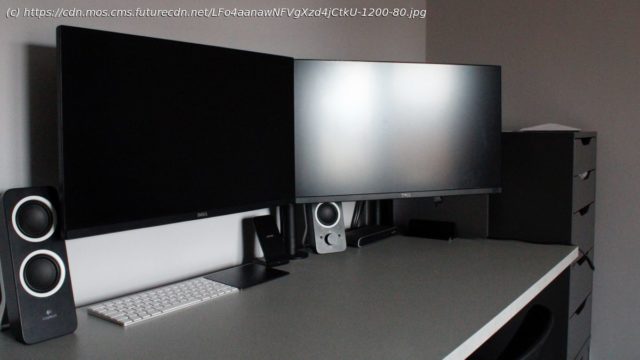We’ve picked out the best monitors for creating a dual monitor setup for expanded screen real estate and productivity.
Every year, monitors get bigger. Should you simply get the largest monitor that you can buy, or would two monitors be better than a huge one like an ultrawide? In this guide, we’ll explore the research that supports using two displays instead of one, and what monitor pair is best for every use case. The main benefit of a dual monitor setup for businesses is productivity. Multiple displays allow you to see more, which eliminates the delays caused by window and application switching. Having a single large monitor has one downside: you can’t easily run multiple applications in full-screen mode. When you use two monitors, you can have one full-screen app, or these days, probably a video call, on one screen while working on the other. Using two monitors is not a fad, the benefits are real and measurable. What was anecdotal evidence and assumption is supported by scientific research too. Behavioral research studies have found a reduction in the time required to complete tasks and significant increases in productivity. Jon Peddie, an influential analyst and an industry pioneer in the field of graphics has done the numbers, and they show a productivity increase of over 40 percent: “We found that users with multiple monitors have an average productivity increase of 42 percent,” Peddie explained. Other experts have validated these assumptions: researchers from the Software Usability Research Laboratory at Wichita State University found 91 percent of users prefer dual monitors to a single monitor during a study completed in 2011. Computers with one and two monitors were used to observe participants as they performed business tasks. People with two displays completed their tasks 18 percent faster. Many even said a pair of smaller screens would be preferable to looking at a single big screen. Back when monitors were big CRT tubes, placing monitors next to one another was the only option but today’s monitors are thin and no longer weigh a ton. With flexible mount options and monitor stands you can easily position the screens to your liking and even stack displays on top of one another if you want to. Some monitors even support screen rotation for “portrait” mode. Lawyers working on long blocks of text and those reading scanned printed documents will benefit from portrait mode, if supported. You will also find that two smaller monitors deliver better results and often end up costing less than buying a single, super-large one. Finally, you don’t need a huge office to take advantage of dual displays: there is a new breed of small 15-inch portable monitors that deliver the high information density of 4K ultra HD without the bulk. These come with their own foldable stands and can be easily slipped into a backpack, taking your dual-screen setup virtually everywhere. When you choose a pair of 4K monitors, make sure your graphics card is capable of handling them. To drive two monitors at 4K you´ll want cards capable of handling two or more displays. Just to mention a few: the Gigabyte Geforce RTX 2060 or the MSI GeForce GTX 1660 can support up to three 4K displays and come with three full size ports. If you are on a tight budget you could have a card like the EVGA GeForce GTX 1080 capable of driving two monitors in 4K at a reasonable price. You can find plenty of options in our graphics cards guides for AMD and Nvidia. We aren’t keen on including prices in buying guides, but for the sake of comparison it’s easiest to display current prices. A pair of 27-inch 4K screens from our best for productivity choice cost less than 600 dollars at the time of writing. There are 8K pixels on a combined display area of 46.98 inches horizontally by 14 inches vertically, and a diagonal size of 49 inches. If you prefer a 49-inch curved display with a resolution of 5120×1440 pixels and they do exist, you’re looking at paying $866 for an entry-level ROG Strix XG49VQ, $1100 for a mid-tier Sceptre Curved 49, and $1349 for a high-tier Samsung Odyssey G9. As a result, you get a gigantic screen designed mostly for gamers, which can only be used as delivered. If you have separate screens, you can move them vertically or horizontally as you wish. A single monitor is also a single point of failure, so if it malfunctions you’re left with nothing to look at. Those who advocate a single monitor can rightly claim that with a single screen there are no bezels to get in the way, there is only a huge smooth surface of continuous pixels. You decide whether visual comfort vs bulkiness is more advantageous for your use case. Proponents of a dual setup say the human brain is very effective at focusing on what is important and ignoring everything else. Therefore, when you start using more than one screen, especially with multiple apps, the middle bezels just disappear Those who wish to work as well as play should consider a pair of these. This display stands out from the competition by its price: it’s one of the most affordable 1440p offerings. Its 27 inch size is ideal and its refresh rate goes up to 75Hz making it suited for light gaming. Its quality 27″ IPS panel offers 178° viewing angles, anti-glare coating to prevent reflections and delivers exceptional color fidelity at 99% of the sRGB color space. Additionally, the display comes equipped with blue light and flicker reduction filters to help reduce eye strain.






